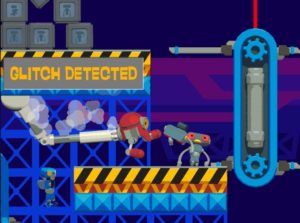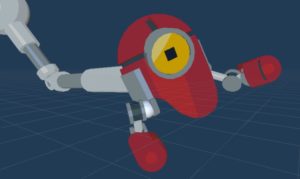
The second game of the ill-fated Xenobots series was made as a direct response to COVID19, as with most things in the last couple of years. The idea was simply to teach children about the basic premise and logic of social distancing, without having to sit them down and spell it out in a boring manner.
In terms of gameplay, X:SD is relatively simple; players are given a sequence of three colors, and must throw balls at falling targets in the same order. Doing so would produce a treat to keep several ‘bots on the side of the screen content while they wait their turns to be treated.
If the player is too slow or gets the wrong sequence, the waiting ‘bots will get impatient, crowding the lower portion of the screen faster than they can be ‘fixed,’ and eventually overwhelming the poor mechanic working on them all, resulting in a game over. If the player manages to last ’till the end, the robots all go to a fun little dance party together, instead.
How do arms work, again?
As with Hammy’s Maze Escape, we wanted to introduce a character specially-tailored to the needs of this particular game. In this case, we needed a doctor -or more accurately, a mechanic. I like the idea of the other ‘bots having to come to see this character whenever they’ve messed up or need help, rather than having this character go visit the others, so I quickly decided on rooting “Doc” in place somehow.
As I was having quite a bit of fun with inverse-kinematics at the time, I decided to take advantage of that to mount Doc on an articulated, extendable robotic arm. Making an IK rig that could bend and rotate on specific axes was simple enough, using a plugin I found on Unity’s Asset Store, but getting the arm to extend and contract dynamically was a much more interesting problem.
To put it simply; every IK solution I tried wanted to treat each half of the piston like separate bones with a rotating joint between them. As far as I could find at the time, there were no solutions that allowed for both sliding and rotating joints in the same limb.
So I faked it.
I made an invisible rig with two bones for every piston, while setting up the rotational joints normally. Then, rather than simply parenting the piston halves to their respective bones and letting them bend and clip through each other, I wrote a script to automatically rotate the piston halves to face each other at all times. With that script, I could parent each piston half to its respective bone with the pivots set right at the ends of either half. This way, with the script active, it looks just like a real piston, and when the invisible armature extends, the pistons are dragged along with it.
Was it perfect? No. Several angles and positions caused the whole rig to twitch and jiggle like Doc was having a seizure, especially near full extension and full retraction of the arms. To be frank, this would never have worked it Doc was going to be animated dynamically. Luckily, all they needed was a set of standard, non-dynamic animations, so the solution held through the final release. The plan was to revisit doc’s rigging mechanism later on, as it was important to get the game out while social distancing was still a fresh and important topic.
How do robots cough..?
Once Doc was ready to go, there was still one character to design. A background character, to be specific. We needed someone to be sick, after all, and at the time it seemed like a good idea to have a more disposable kind of ‘bot handy for background or fodder roles in future games.
The end product was a nameless little ‘bot designed to be as simple and easy-to-use as possible. Instead of legs, this random ‘bot simply hovers. Instead of arms that need complex IK solutions to bend and rotate at the right spots, he has simple noodle-arms a la Bender from Futurama.
To represent illness, I made a series of cartoon-y spark and lightning bolt particles that would emit from the broken ‘bots as they wait to be seen by Doc. This, plus a secondary drab paint job, made it relatively easy for children to tell the “sick” ‘bots from the “healthy” ones.
